英国文学史文艺复兴时期复习资料
- 格式:doc
- 大小:41.00 KB
- 文档页数:3
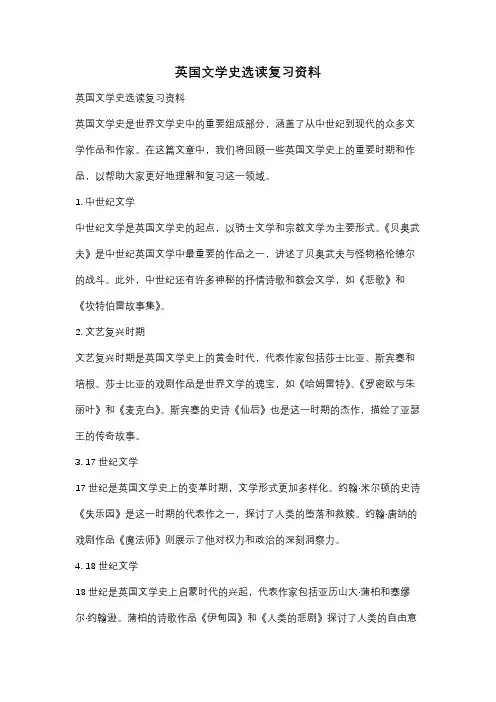
英国文学史选读复习资料英国文学史选读复习资料英国文学史是世界文学史中的重要组成部分,涵盖了从中世纪到现代的众多文学作品和作家。
在这篇文章中,我们将回顾一些英国文学史上的重要时期和作品,以帮助大家更好地理解和复习这一领域。
1. 中世纪文学中世纪文学是英国文学史的起点,以骑士文学和宗教文学为主要形式。
《贝奥武夫》是中世纪英国文学中最重要的作品之一,讲述了贝奥武夫与怪物格伦德尔的战斗。
此外,中世纪还有许多神秘的抒情诗歌和教会文学,如《悲歌》和《坎特伯雷故事集》。
2. 文艺复兴时期文艺复兴时期是英国文学史上的黄金时代,代表作家包括莎士比亚、斯宾塞和培根。
莎士比亚的戏剧作品是世界文学的瑰宝,如《哈姆雷特》、《罗密欧与朱丽叶》和《麦克白》。
斯宾塞的史诗《仙后》也是这一时期的杰作,描绘了亚瑟王的传奇故事。
3. 17世纪文学17世纪是英国文学史上的变革时期,文学形式更加多样化。
约翰·米尔顿的史诗《失乐园》是这一时期的代表作之一,探讨了人类的堕落和救赎。
约翰·唐纳的戏剧作品《魔法师》则展示了他对权力和政治的深刻洞察力。
4. 18世纪文学18世纪是英国文学史上启蒙时代的兴起,代表作家包括亚历山大·蒲柏和塞缪尔·约翰逊。
蒲柏的诗歌作品《伊甸园》和《人类的悲剧》探讨了人类的自由意志和苦难。
约翰逊的《英语词典》对英语语言的规范化和发展起了重要作用。
5. 浪漫主义文学浪漫主义文学是19世纪英国文学的重要流派,代表作家包括威廉·华兹华斯和塞缪尔·泰勒·柯勒律治。
华兹华斯的诗歌作品《抒情诗集》和《普雷德斯》强调了自然和个人情感的重要性。
柯勒律治的《抒情诗集》则表达了对自然的热爱和对社会不公的关注。
6. 维多利亚时代文学维多利亚时代是英国文学史上的繁荣时期,代表作家包括查尔斯·狄更斯和艾米莉·勃朗特。
狄更斯的小说《雾都孤儿》和《双城记》揭示了当时社会的不公和贫困问题。
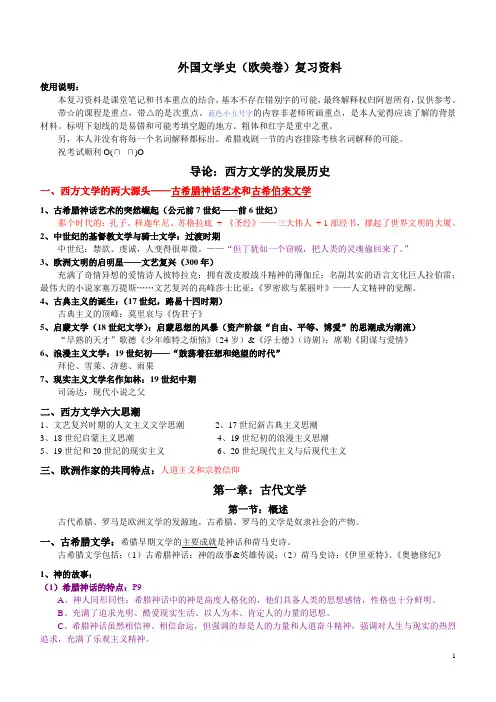
外国文学史(欧美卷)复习资料使用说明:本复习资料是课堂笔记和书本重点的结合,基本不存在错别字的可能,最终解释权归阿崽所有,仅供参考。
带☆的课程是重点,带△的是次重点。
蓝色小五号字的内容非老师所画重点,是本人觉得应该了解的背景材料。
标明下划线的是易错和可能考填空题的地方。
粗体和红字是重中之重。
另,本人并没有将每一个名词解释都标出。
希腊戏剧一节的内容排除考核名词解释的可能。
祝考试顺利O(∩_∩)O导论:西方文学的发展历史一、西方文学的两大源头——古希腊神话艺术和古希伯来文学1、古希腊神话艺术的突然崛起(公元前7世纪——前6世纪)那个时代的:孔子、释迦牟尼、苏格拉底+ 《圣经》——三大伟人+ 1部经书,撑起了世界文明的大厦。
2、中世纪的基督教文学与骑士文学:过渡时期中世纪:禁欲、虔诚,人变得很卑微。
——“但丁犹如一个窃贼,把人类的灵魂偷回来了。
”3、欧洲文明的启明星——文艺复兴(300年)充满了奇情异想的爱情诗人彼特拉克;拥有泼皮般战斗精神的薄伽丘;名副其实的语言文化巨人拉伯雷;最伟大的小说家塞万提斯……文艺复兴的高峰莎士比亚:《罗密欧与茱丽叶》——人文精神的觉醒。
4、古典主义的诞生:(17世纪,路易十四时期)古典主义的顶峰:莫里哀与《伪君子》5、启蒙文学(18世纪文学):启蒙思想的风暴(资产阶级“自由、平等、博爱”的思潮成为潮流)“早熟的天才”歌德《少年维特之烦恼》(24岁)&《浮士德》(诗剧);席勒《阴谋与爱情》6、浪漫主义文学:19世纪初——“鼓荡着狂想和绝望的时代”拜伦、雪莱、济慈、雨果7、现实主义文学名作如林:19世纪中期司汤达:现代小说之父二、西方文学六大思潮1、文艺复兴时期的人文主义文学思潮2、17世纪新古典主义思潮3、18世纪启蒙主义思潮4、19世纪初的浪漫主义思潮5、19世纪和20世纪的现实主义6、20世纪现代主义与后现代主义三、欧洲作家的共同特点:人道主义和宗教信仰第一章:古代文学第一节:概述古代希腊、罗马是欧洲文学的发源地。
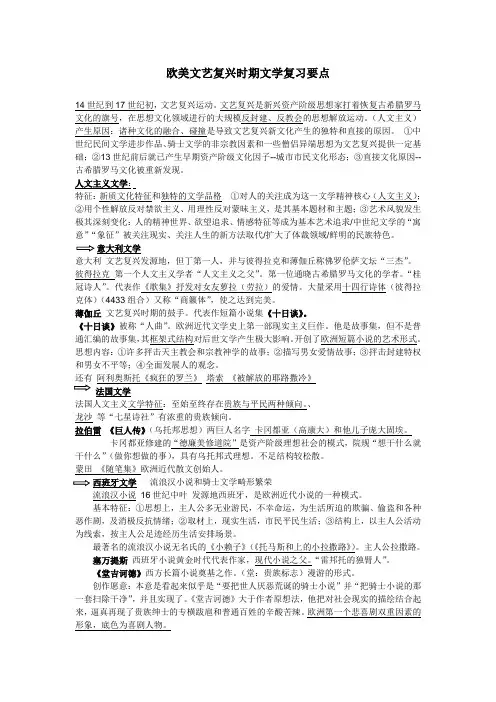
欧美文艺复兴时期文学复习要点14世纪到17世纪初,文艺复兴运动。
文艺复兴是新兴资产阶级思想家打着恢复古希腊罗马文化的旗号,在思想文化领域进行的大规模反封建、反教会的思想解放运动。
(人文主义)产生原因:诸种文化的融合、碰撞是导致文艺复兴新文化产生的独特和直接的原因。
①中世纪民间文学进步作品、骑士文学的非宗教因素和一些僧侣异端思想为文艺复兴提供一定基础;②13世纪前后就已产生早期资产阶级文化因子--城市市民文化形态;③直接文化原因--古希腊罗马文化被重新发现。
人文主义文学:特征:新质文化特征和独特的文学品格①对人的关注成为这一文学精神核心(人文主义);②用个性解放反对禁欲主义、用理性反对蒙昧主义,是其基本题材和主题;③艺术风貌发生极其深刻变化:人的精神世界、欲望追求、情感特征等成为基本艺术追求/中世纪文学的“寓意”“象征”被关注现实、关注人生的新方法取代/扩大了体裁领域/鲜明的民族特色。
意大利文学意大利文艺复兴发源地,但丁第一人,并与彼得拉克和薄伽丘称佛罗伦萨文坛“三杰”。
彼得拉克第一个人文主义学者“人文主义之父”。
第一位通晓古希腊罗马文化的学者。
“桂冠诗人”。
代表作《歌集》抒发对女友萝拉(劳拉)的爱情。
大量采用十四行诗体(彼得拉克体)(4433组合)又称“商籁体”,使之达到完美。
薄伽丘文艺复兴时期的鼓手。
代表作短篇小说集《十日谈》。
《十日谈》被称“人曲”。
欧洲近代文学史上第一部现实主义巨作。
他是故事集,但不是普通汇编的故事集,其框架式结构对后世文学产生极大影响。
开创了欧洲短篇小说的艺术形式。
思想内容:①许多抨击天主教会和宗教神学的故事;②描写男女爱情故事;③抨击封建特权和男女不平等;④全面发展人的观念。
还有阿利奥斯托《疯狂的罗兰》塔索《被解放的耶路撒冷》法国文学法国人文主义文学特征:至始至终存在贵族与平民两种倾向。
、龙沙等“七星诗社”有浓重的贵族倾向。
拉伯雷《巨人传》(乌托邦思想)两巨人名字卡冈都亚(高康大)和他儿子庞大固埃。
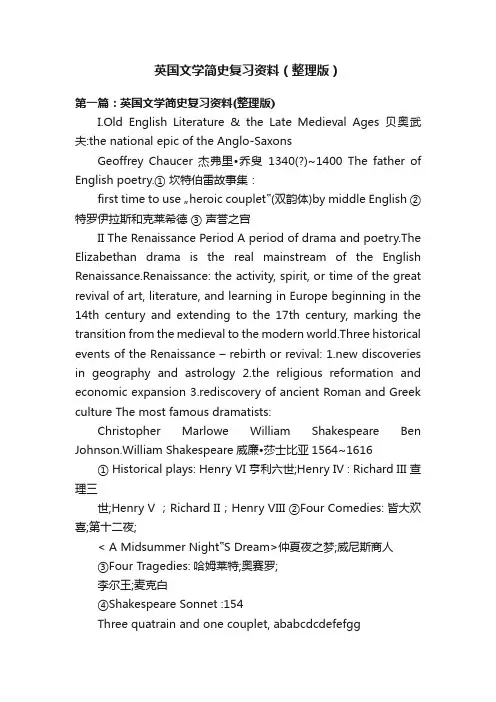
英国文学简史复习资料(整理版)第一篇:英国文学简史复习资料(整理版)I.Old English Literature & the Late Medieval Ages 贝奥武夫:the national epic of the Anglo-SaxonsGeoffrey Chaucer 杰弗里•乔叟1340(?)~1400 The father of English poetry.① 坎特伯雷故事集:first time to use …heroic couplet‟(双韵体)by middle English ②特罗伊拉斯和克莱希德③ 声誉之宫II The Renaissance Period A period of drama and poetry.The Elizabethan drama is the real mainstream of the English Renaissance.Renaissance: the activity, spirit, or time of the great revival of art, literature, and learning in Europe beginning in the 14th century and extending to the 17th century, marking the transition from the medieval to the modern world.Three historical events of the Renaissance – rebirth or revival: 1.new discoveries in geography and astrology 2.the religious reformation and economic expansion 3.rediscovery of ancient Roman and Greek culture The most famous dramatists:Christopher Marlowe William Shakespeare Ben Johnson.William Shakespeare威廉•莎士比亚1564~1616① Historical plays: Henry VI 亨利六世;Henry IV : Richard III 查理三世;Henry V ;Richard II;Henry VIII ②Four Comedies: 皆大欢喜;第十二夜;< A Midsummer Night‟S Dream>仲夏夜之梦;威尼斯商人③Four Tragedies: 哈姆莱特;奥赛罗;李尔王;麦克白④Shakespeare Sonnet :154Three quatrain and one couplet, ababcdcdefefggA sonnet is a lyric consisting of 14 lines, usually iniambic pentameter restricted to a definition rhyme scheme.⑤the comedy of errors 错中错,Titus Andronicus泰特斯·安特洛尼克斯,The Taming of the shrew 驯悍记Love's labour's lost(爱的徒劳)Romeo and Juliet 罗密欧与朱丽叶Much ado about nothing(无事生非)The merry wives of Windsor.温莎的风流娘们King John 约翰王All's well that ends well 终成眷属Measure for measure(一报还一报)Bacon: Of Studies;Of Beauty;Of Marriage and Single Life English Bourgeois Revolution,学术的推进 III:the period of the English bourgeois ton:1608~1674Paradise Lost;Samson Agonistes(力士参孙);On the morning of Christ’s Nativity,复乐园我的失明论出版自由为英国人民声辩Bunyan: 1628~1688 ①Religionary Allegory:天路历程Grace Abounding to the Chief of Sinner;the Holy War John Don: the Metaphysical poet(玄学派诗人).Metaphysical Poetry(玄学诗):(用语)the diction is simple, the imagery is from the actual,(形式)the form is frequently an argument with the poet’s beloved, with god, or with himself.(主题:love, religious, thought)The Flea;跳蚤Forbbiding Mourning,Songs And Sonnets歌与十四行诗,emergent occasions 突变引起的诚念Hely sonnets IV The 18th Century:EnlightenmentA revival of interest in the old classical works, order, logic, restrained emotion(抑制情感)and accuracy The Age ofEnlightenment/Reason: the movement was a furtherance of the Renaissance of the 15th and 16th centries, a progressive intellectual movement, reason(rationality), equality&science(the 18th century)小说崛起:In the mid-century, the newly literary form, modern English novel rised(realistic novel现实主义小说)Gothic novel(哥特式小说):mystery, horror, castles(from middle part to the end of century)Jonathan Swift乔纳森•斯威夫特1667~1745(十八世纪杰出的政论家和讽刺小说家 a master satirist。
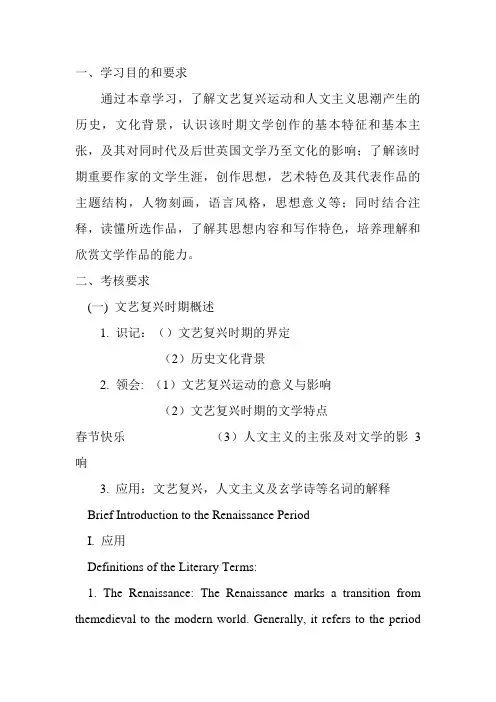
一、学习目的和要求通过本章学习,了解文艺复兴运动和人文主义思潮产生的历史,文化背景,认识该时期文学创作的基本特征和基本主张,及其对同时代及后世英国文学乃至文化的影响;了解该时期重要作家的文学生涯,创作思想,艺术特色及其代表作品的主题结构,人物刻画,语言风格,思想意义等;同时结合注释,读懂所选作品,了解其思想内容和写作特色,培养理解和欣赏文学作品的能力。
二、考核要求(一) 文艺复兴时期概述1. 识记:()文艺复兴时期的界定(2)历史文化背景2. 领会: (1)文艺复兴运动的意义与影响(2)文艺复兴时期的文学特点春节快乐(3)人文主义的主张及对文学的影3响3. 应用:文艺复兴,人文主义及玄学诗等名词的解释Brief Introduction to the Renaissance PeriodI. 应用Definitions of the Literary Terms:1. The Renaissance: The Renaissance marks a transition from themedieval to the modern world. Generally, it refers to the periodbetween the 14th & 17th centuries. It first started in Italy, with the flowering of painting, sculpture & literature. From Italy the movement went to embrace the rest of Europe. The Renaissance, which means "rebirth" or "revival," is actually a movement stimulated by a series of historical events, such as the re-discovery of ancient Roman & Greek culture, the new discoveries in geography & astrology, the religious reformation & the economic expansion. The Renaissance, therefore, in essence is a historical period in which the European humanist thinkers & scholars made attempts to get rid of those old feudalist ideas in medieval Europe, to introduce new ideas that expressed the interests of the rising bourgeoisie, & to recover the purity of the early church from the corruption of the Roman Catholic Church.2. Humanism: Humanism is the essence of the Renaissance. It sprang from the endeavor to restore a medieval reverence for the ancient authors and is frequently taken as the beginning of the Renaissance on its conscious, intellectual side, for the Greek and Roman civilization was based on such a conception that man is the measure of all things. Through the new learning, humanists not only saw the arts of splendor and enlightenment, but the human values represented in the works. Renaissance humanists found in the classics a justification to exalt human nature and came to see thathuman beings were glorious creatures capable of individual development in the direction of perfections, and that the world they inhabited was theirs not to despise but to question, explore, and enjoy. Thus, by emphasizing the dignity of human beings and the importance of the present life, they voiced their beliefs that man did not only have the right to enjoy the beauty of this life, but had the ability to perfect himself and to perform wonders. Thomas More, Christopher Marlowe and William Shakespeare are the best representatives of the English humanists.3. Spenserian stanza:Spenserian stanza was invented by Edmund Spenser. It is a stanza of nine lines, with the first eight lines in iambic pentameter & the last line in iambic hexameter, rhyming ababbcbcc.4. Metaphysical poetry: The term "metaphysical poetry" is commonly used to name the work of the 17th century writers who wrote under the influence of John Donne. With a rebellious spirit, the metaphysical poets tried to break away from the conventional fashion of the Elizabethan love poetry. The diction is simple as compared with that of the Elizabethan or the Neoclassic periods, and echoes the words and cadences of common speech. The imagery isdrawn from the actual life. The form is frequently that of an argument with the poet's beloved, with God, or with himself.5. The Renaissance 对不起,我这个心直口快的人是内向的。
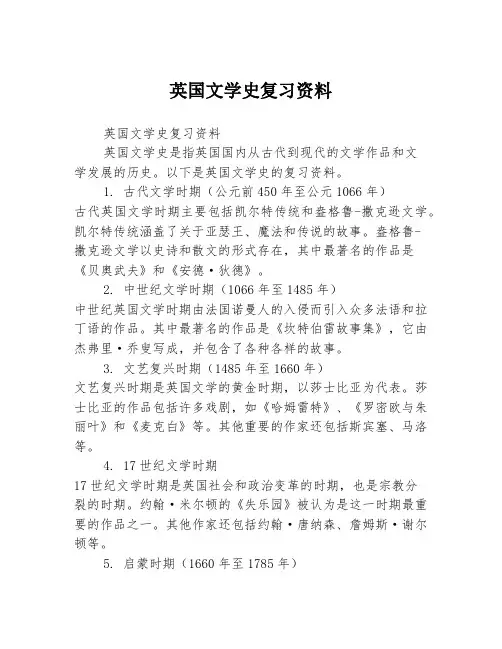
英国文学史复习资料英国文学史复习资料英国文学史是指英国国内从古代到现代的文学作品和文学发展的历史。
以下是英国文学史的复习资料。
1. 古代文学时期(公元前450年至公元1066年)古代英国文学时期主要包括凯尔特传统和盎格鲁-撒克逊文学。
凯尔特传统涵盖了关于亚瑟王、魔法和传说的故事。
盎格鲁-撒克逊文学以史诗和散文的形式存在,其中最著名的作品是《贝奥武夫》和《安德·狄德》。
2. 中世纪文学时期(1066年至1485年)中世纪英国文学时期由法国诺曼人的入侵而引入众多法语和拉丁语的作品。
其中最著名的作品是《坎特伯雷故事集》,它由杰弗里·乔叟写成,并包含了各种各样的故事。
3. 文艺复兴时期(1485年至1660年)文艺复兴时期是英国文学的黄金时期,以莎士比亚为代表。
莎士比亚的作品包括许多戏剧,如《哈姆雷特》、《罗密欧与朱丽叶》和《麦克白》等。
其他重要的作家还包括斯宾塞、马洛等。
4. 17世纪文学时期17世纪文学时期是英国社会和政治变革的时期,也是宗教分裂的时期。
约翰·米尔顿的《失乐园》被认为是这一时期最重要的作品之一。
其他作家还包括约翰·唐纳森、詹姆斯·谢尔顿等。
5. 启蒙时期(1660年至1785年)启蒙时期是英国文学史上的一次重要转折点,代表了对理性、科学和自由思想的追求。
著名作家包括强纳森·斯威夫特、丹尼尔·笛福、亚历山大·蒲柏、简·奥斯汀等。
6. 浪漫主义时期(1785年至1837年)浪漫主义时期是对启蒙时期理性主义的反应。
浪漫主义作品强调情感、个人主义和自然。
威廉·华兹华斯、塞缪尔·柯勒律治、约翰·济慈等都是这一时期的重要作家。
7. 维多利亚时代(1837年至1901年)维多利亚时代是英国帝国的鼎盛时期,文学作品多样化。
查尔斯·狄更斯的《雾都孤儿》、古斯塔夫·福楼拜的《名利场》等作品成为经典。
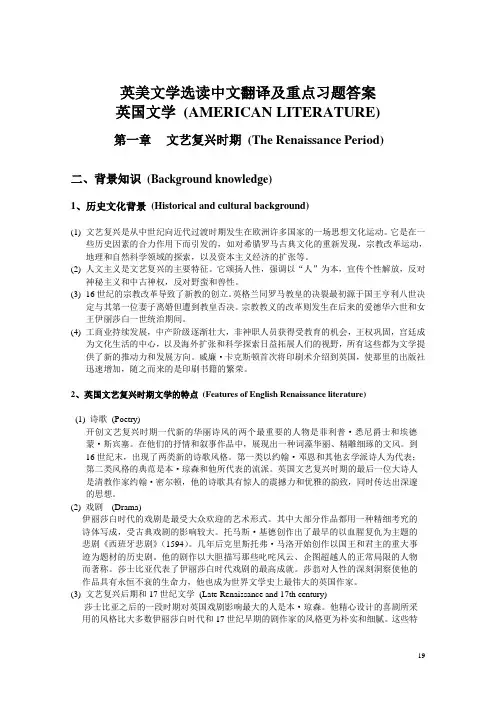
英美文学选读中文翻译及重点习题答案英国文学(AMERICAN LITERATURE)第一章文艺复兴时期(The Renaissance Period)二、背景知识(Background knowledge)1、历史文化背景(Historical and cultural background)(1)文艺复兴是从中世纪向近代过渡时期发生在欧洲许多国家的一场思想文化运动。
它是在一些历史因素的合力作用下而引发的,如对希腊罗马古典文化的重新发现,宗教改革运动,地理和自然科学领域的探索,以及资本主义经济的扩张等。
(2)人文主义是文艺复兴的主要特征。
它颂扬人性,强调以“人”为本,宣传个性解放,反对神秘主义和中古神权,反对野蛮和兽性。
(3)16世纪的宗教改革导致了新教的创立。
英格兰同罗马教皇的决裂最初源于国王亨利八世决定与其第一位妻子离婚但遭到教皇否决。
宗教教义的改革则发生在后来的爱德华六世和女王伊丽莎白一世统治期间。
(4)工商业持续发展,中产阶级逐渐壮大,非神职人员获得受教育的机会,王权巩固,宫廷成为文化生活的中心,以及海外扩张和科学探索日益拓展人们的视野,所有这些都为文学提供了新的推动力和发展方向。
威廉·卡克斯顿首次将印刷术介绍到英国,使那里的出版社迅速增加,随之而来的是印刷书籍的繁荣。
2、英国文艺复兴时期文学的特点(Features of English Renaissance literature)(1) 诗歌(Poetry)开创文艺复兴时期一代新的华丽诗风的两个最重要的人物是菲利普·悉尼爵士和埃德蒙·斯宾塞。
在他们的抒情和叙事作品中,展现出一种词藻华丽、精雕细琢的文风。
到16世纪末,出现了两类新的诗歌风格。
第一类以约翰·邓恩和其他玄学派诗人为代表;第二类风格的典范是本·琼森和他所代表的流派。
英国文艺复兴时期的最后一位大诗人是清教作家约翰·密尔顿,他的诗歌具有惊人的震撼力和优雅的韵致,同时传达出深邃的思想。
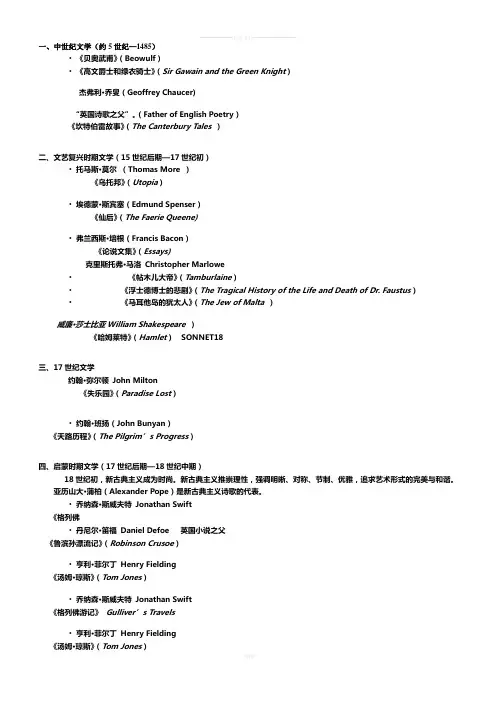
-------------精选文档-----------------一、中世纪文学(约5世纪—1485)•《贝奥武甫》(Beowulf)•《高文爵士和绿衣骑士》(Sir Gawain and the Green Knight )杰弗利·乔叟(Geoffrey Chaucer)“英国诗歌之父”。
(Father of English Poetry)《坎特伯雷故事》(The Canterbury Tales)二、文艺复兴时期文学(15世纪后期—17世纪初)•托马斯·莫尔(Thomas More )《乌托邦》(Utopia)•埃德蒙·斯宾塞(Edmund Spenser)《仙后》(The Faerie Queene)•弗兰西斯·培根(Francis Bacon)《论说文集》(Essays)克里斯托弗·马洛Christopher Marlowe•《帖木儿大帝》(Tamburlaine)•《浮士德博士的悲剧》(The Tragical History of the Life and Death of Dr. Faustus)•《马耳他岛的犹太人》(The Jew of Malta)威廉·莎士比亚William Shakespeare )《哈姆莱特》(Hamlet)SONNET18三、17世纪文学约翰·弥尔顿John Milton《失乐园》(Paradise Lost)•约翰·班扬(John Bunyan)《天路历程》(The Pilgrim’s Progress)四、启蒙时期文学(17世纪后期—18世纪中期)18世纪初,新古典主义成为时尚。
新古典主义推崇理性,强调明晰、对称、节制、优雅,追求艺术形式的完美与和谐。
亚历山大·蒲柏(Alexander Pope)是新古典主义诗歌的代表。
•乔纳森·斯威夫特Jonathan Swift《格列佛•丹尼尔·笛福Daniel Defoe 英国小说之父《鲁滨孙漂流记》(Robinson Crusoe)•亨利·菲尔丁Henry Fielding《汤姆·琼斯》(Tom Jones)•乔纳森·斯威夫特Jonathan Swift《格列佛游记》Gulliver’s Travels•亨利·菲尔丁Henry Fielding《汤姆·琼斯》(Tom Jones)-------------精选文档-----------------托马斯·格雷Thomas Gray《墓园哀歌》(Elegy Written in a Country Churchyard)五、浪漫主义时期文学(1798-1832)•罗伯特·彭斯Robert Burns•威廉·布莱克William Blake•威廉·华兹华斯William Wordsworth•塞缪尔·泰勒·柯勒律治Samuel Taylor Coleridge《抒情歌谣集》(Lyrical Ballads)一. Old English Literature & The Late Medieval Ages中世纪文学(约5世纪—1485)<Beowulf>贝奥武夫:the national epic of the Anglo-SaxonsEpic:long narrative poems that record the adventures or heroic deeds of a hero enacted in vast landscapes. The style of epic is grand and elevated.e.g. Homer’s Iliad and OdysseyArtistic features:ing alliterationDefinition of alliteration: a rhetorical device, meaning some words in a sentence begin with the same consonant sound(头韵)Some examples on P5ing metaphor and understatementDefinition of understatement: expressing something in a controlled way Understatement is a typical way for Englishmen to express their ideasGeoffery Chaucer 杰弗里·乔叟1340(?)~1400(首创“双韵体”,英国文学史上首先用伦敦方言写作。
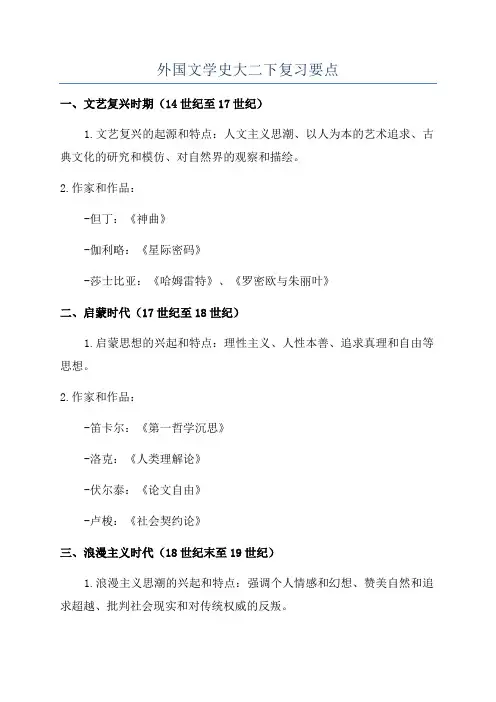
外国文学史大二下复习要点一、文艺复兴时期(14世纪至17世纪)1.文艺复兴的起源和特点:人文主义思潮、以人为本的艺术追求、古典文化的研究和模仿、对自然界的观察和描绘。
2.作家和作品:-但丁:《神曲》-伽利略:《星际密码》-莎士比亚:《哈姆雷特》、《罗密欧与朱丽叶》二、启蒙时代(17世纪至18世纪)1.启蒙思想的兴起和特点:理性主义、人性本善、追求真理和自由等思想。
2.作家和作品:-笛卡尔:《第一哲学沉思》-洛克:《人类理解论》-伏尔泰:《论文自由》-卢梭:《社会契约论》三、浪漫主义时代(18世纪末至19世纪)1.浪漫主义思潮的兴起和特点:强调个人情感和幻想、赞美自然和追求超越、批判社会现实和对传统权威的反叛。
2.作家和作品:-达·昆西:《非法的结婚》-弗拉戈纳尔:《玛尔图·斯图亚特》-歌德:《浮士德》四、现实主义时代(19世纪末至20世纪初)1.现实主义思潮的兴起和特点:关注社会现实和人民生活、追求真实和可信的描写、反对浪漫主义的虚幻和抽象。
2.作家和作品:-陀思妥耶夫斯基:《罪与罚》-托尔斯泰:《战争与和平》-巴尔扎克:《人间喜剧》-奥斯卡·王尔德:《道林·格雷的画像》五、现代主义时代(20世纪初至20世纪中期)1.现代主义思潮的兴起和特点:对传统文学规范的挑战、多样性和实验性的创作风格、对现代生活和心理状态的描绘。
2.作家和作品:-乔伊斯:《尤利西斯》-布莱希特:《死亡的生活》-普鲁斯特:《追忆似水年华》-笑傲江湖:《荒原狼》六、后现代主义时代(20世纪末至21世纪)1.后现代主义思潮的兴起和特点:质疑固有的真理和意义、游离于传统框架之外、强调语言和符号的作用。
2.作家和作品:-卡尔维诺:《看不见的城市》-塞林格:《麦田里的守望者》-伍尔夫:《到灯塔去》。
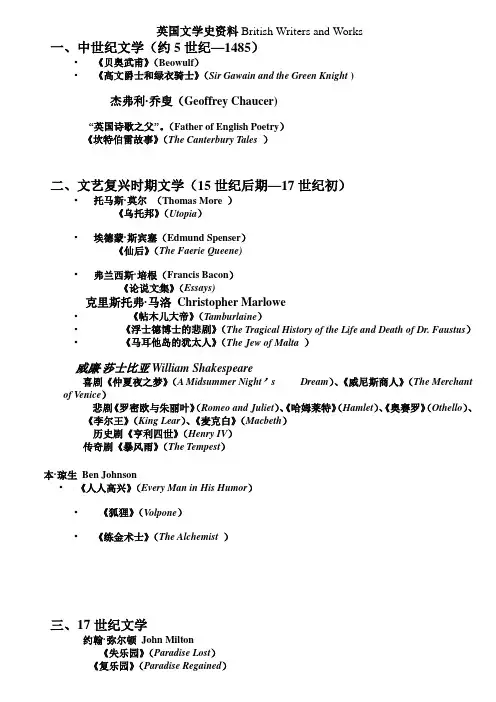
英国文学史资料British Writers and Works一、中世纪文学(约5世纪—1485)•《贝奥武甫》(Beowulf)•《高文爵士和绿衣骑士》(Sir Gawain and the Green Knight )杰弗利·乔叟(Geoffrey Chaucer)“英国诗歌之父”。
(Father of English Poetry)《坎特伯雷故事》(The Canterbury Tales)二、文艺复兴时期文学(15世纪后期—17世纪初)•托马斯·莫尔(Thomas More )《乌托邦》(Utopia)•埃德蒙·斯宾塞(Edmund Spenser)《仙后》(The Faerie Queene)•弗兰西斯·培根(Francis Bacon)《论说文集》(Essays)克里斯托弗·马洛Christopher Marlowe•《帖木儿大帝》(Tamburlaine)•《浮士德博士的悲剧》(The Tragical History of the Life and Death of Dr. Faustus)•《马耳他岛的犹太人》(The Jew of Malta)威廉·莎士比亚William Shakespeare喜剧《仲夏夜之梦》(A Midsummer Night’s Dream)、《威尼斯商人》(The Merchant of Venice)悲剧《罗密欧与朱丽叶》(Romeo and Juliet)、《哈姆莱特》(Hamlet)、《奥赛罗》(Othello)、《李尔王》(King Lear)、《麦克白》(Macbeth)历史剧《亨利四世》(Henry IV)传奇剧《暴风雨》(The Tempest)本·琼生Ben Johnson•《人人高兴》(Every Man in His Humor)•《狐狸》(V olpone)•《练金术士》(The Alchemist)三、17世纪文学约翰·弥尔顿John Milton《失乐园》(Paradise Lost)《复乐园》(Paradise Regained)诗剧《力士参孙》(Samson Agonistes)•约翰·班扬(John Bunyan)《天路历程》(The Pilgrim’s Progress)•威廉·康格里夫(William Congreve)《以爱还爱》(Love for Love)《如此世道》(The Way of the World)四、启蒙时期文学(17世纪后期—18世纪中期)18世纪初,新古典主义成为时尚。
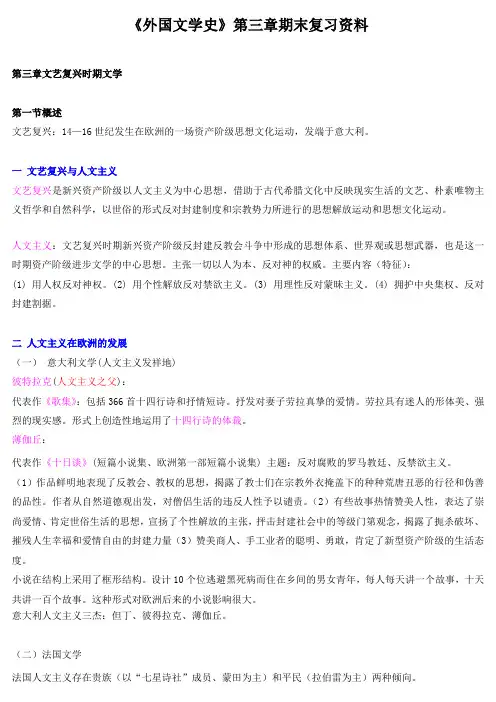
《外国文学史》第三章期末复习资料第三章文艺复兴时期文学第一节概述文艺复兴:14—16世纪发生在欧洲的一场资产阶级思想文化运动,发端于意大利。
一文艺复兴与人文主义文艺复兴是新兴资产阶级以人文主义为中心思想,借助于古代希腊文化中反映现实生活的文艺、朴素唯物主义哲学和自然科学,以世俗的形式反对封建制度和宗教势力所进行的思想解放运动和思想文化运动。
人文主义:文艺复兴时期新兴资产阶级反封建反教会斗争中形成的思想体系、世界观或思想武器,也是这一时期资产阶级进步文学的中心思想。
主张一切以人为本、反对神的权威。
主要内容(特征):(1) 用人权反对神权。
(2) 用个性解放反对禁欲主义。
(3) 用理性反对蒙昧主义。
(4) 拥护中央集权、反对封建割据。
二人文主义在欧洲的发展(一)意大利文学(人文主义发祥地)彼特拉克(人文主义之父):代表作《歌集》:包括366首十四行诗和抒情短诗。
抒发对妻子劳拉真挚的爱情。
劳拉具有迷人的形体美、强烈的现实感。
形式上创造性地运用了十四行诗的体裁。
薄伽丘:代表作《十日谈》(短篇小说集、欧洲第一部短篇小说集) 主题:反对腐败的罗马教廷、反禁欲主义。
(1)作品鲜明地表现了反教会、教权的思想,揭露了教士们在宗教外衣掩盖下的种种荒唐丑恶的行径和伪善的品性。
作者从自然道德观出发,对僧侣生活的违反人性予以谴责。
(2)有些故事热情赞美人性,表达了崇尚爱情、肯定世俗生活的思想,宣扬了个性解放的主张,抨击封建社会中的等级门第观念,揭露了扼杀破坏、摧残人生幸福和爱情自由的封建力量(3)赞美商人、手工业者的聪明、勇敢,肯定了新型资产阶级的生活态度。
小说在结构上采用了框形结构。
设计10个位逃避黑死病而住在乡间的男女青年,每人每天讲一个故事,十天共讲一百个故事。
这种形式对欧洲后来的小说影响很大。
意大利人文主义三杰:但丁、彼得拉克、薄伽丘。
(二)法国文学法国人文主义存在贵族(以“七星诗社”成员、蒙田为主)和平民(拉伯雷为主)两种倾向。
英国文学史复习资料英国文学史复习资料第一章:中世纪文学1.1 安格鲁-撒克逊时期(5世纪-1066年)- 口头传统和史诗:《贝奥武夫》- 基督教文学:《凡尔登战役》1.2 后征服时期(1066年-1485年)- 基督教文学:《格尔罗与黛斯蒙德》- 骑士文学:《亚瑟王传说》、《罗宾汉传》第二章:文艺复兴时期(1485年-1603年)2.1 草原学派- 约翰·斯克利- 托马斯·莫尔2.2 伊丽莎白时代- 威廉·莎士比亚:《哈姆雷特》、《罗密欧与朱丽叶》 - 克里斯托弗·马洛:《第一部十诫》第三章:17世纪文学3.1 评剧派- 本·琼生:《伊丽莎白时代断头台上的十一个人》- 约翰·福特:《佩里克尔斯·普林》3.2 枪炮派- 约翰·洛克:《论人类理解》- 托马斯·霍布斯:《利维坦》第四章:启蒙时代(18世纪)4.1 洛克主义- 亚当·斯密:《国富论》- 大卫·休谟:《人性的研究》4.2 唯理主义- 亚历山大·波佩:《怪异小说》- 理查德·斯蒂文森:《金银岛》第五章:浪漫主义(19世纪)5.1 威廉·华兹华斯:《抒情诗》5.2 柯勒律治:《唐吉诃德》第六章:维多利亚时代6.1 珍奥斯汀:《傲慢与偏见》6.2 狄更斯:《雾都孤儿》6.3 奥斯卡·王尔德:《道林·格雷的画像》第七章:现代主义(20世纪)7.1 弗吉尼亚·伍尔夫:《至灵宴》7.2 乔治·奥威尔:《1984》7.3 约瑟夫·康拉德:《黑暗之心》第八章:后现代主义(20世纪末至今)8.1 萨尔曼·鲁西迪:《午夜的孩子》8.2 伊恩·麦克尤恩:《第二个苏格拉底》8.3 泽拉尔·纳西莫夫:《洛丽塔》总结:英国文学史涵盖了从中世纪到现代的丰富多样的文学作品。
1TheAnglo -SaxonPeriod(450 -1066)一、不列颠岛上的Settler换了一波又一波Celts (600B.C.)-Romans (55B.C.)-Anglo-Saxons (450A.D.)-Normans (1066A.D.) 二、两个流派三、Beowulf体裁:Epic来源:based on partly historical and partly legendary materials, brought over by the Anglo -Saxons from their original homes.特点:1. Alliteration 头韵 2. Kenning 比喻的复合辞 3.Repetition2TheNormanPeriod(1066 -1350)一、1066 年The Norman Conquest 诺曼征服Significance: 1. Feudal system was established in England.2.English social life greatly changed.3.Connection of English & French.4.Dividing line of Old English and Middle English二、Romance1.Popular form of literature of the upper class in feudal England in the Medieval Ages;2.Knights are major characters;3.Emphasis of chivalry spirit and loyalty to King;posed by the noble, for the noble and of the noble;课本P12 In subject matters, romance naturally falls under three categories:1.2.3.3TheAgeofChaucer(1350 -1400)一、Who is Chaucer?英国摆脱中古时期浪漫主义的第一位现实主义诗人二、两个事件1.The Hundred Years War 百年战争(英VS 法)2.The Peasant Uprising of 1381 (打仗没钱了管peasant 要,于是peasant 揭竿而起)三、John Wycliff1.He was the major person who translated Bible into Middle English, which is important to English Literature and English Language2.He fixed a national standard for English prose to replace various dialects. His works earned him the title of Father of English prose.普通话第一人四、Geoffery Chaucer 乔叟1.The works of Chaucer are roughly divided into 3 periods 课本P182.The significance of The Canterbury Tales is as follows 课本P194TheFifteenthCentury(1400 -1550)一、两个战争和两个事件1.The Hundred Years, War 百年战争1337 -14532.The War of the Roses 玫瑰战争1455-14853.The discovery of America and the new sea routes4.Reformation of the Church二、Popular ballads民谣是这一时期主要体裁1. five basic characteristics 课本P362.重要作品Robin Hood Ballads侠盗罗宾汉5TheEnglishRenaissance(1550 -1642)一、英国文艺复兴时期在位的女王是Queen Elizabeth (1558-1603)伊丽莎白一世二、思想:Humanism (Man is the measure of all things)1.It was against human nature to sacrifice the happiness of this life for an after life; the pursuit of this life.2.Man should be given full freedom to enrich their intellectual and emotional life.三、Edmund Spenser是英国文艺复兴时期的伟大诗人四、英国文艺复兴时期的主流文学形式是Drama6TheSeventeenthCentury(1603 -1688)一、Key words of period of Revolution and RestorationBourgeois资产阶级Anglican Church英国国教Puritans清教徒Charles I查理一世1641 年Grand Remonstrance 大抗议书Commonwealth 英联邦Cromwell in 1653 the Lord Protector 护国公克伦威尔The Bill of Rights 权利法案二、King James Version of the Bible (钦定版圣经),是《圣经》的诸多英文版本之一,于1611 年出版。
英国文学史复习资料一、早期文学1、凯尔特文学:凯尔特人是英国最早的民族,他们有自己的语言和神话传说。
他们的文学作品包括《德鲁伊特教义》和《芬尼亚传奇》。
2、盎格鲁-撒克逊文学:随着罗马帝国的衰落,日耳曼部落开始在英国定居。
盎格鲁-撒克逊时期最著名的文学作品是《贝奥武夫》,讲述了一位英勇的武士贝奥武夫的故事。
二、中世纪文学1、英雄史诗:中世纪时期,英国出现了许多描写骑士和英雄事迹的史诗,如《罗兰之歌》、《希尔德布兰德之歌》等。
2、骑士文学:随着封建制度的发展,骑士成为英国社会的一个重要阶层。
骑士文学主要描写骑士的冒险经历和爱情故事,如《亚瑟王传奇》等。
3、宗教文学:中世纪时期,英国的宗教文学也很发达。
最有名的作品是《神曲》和《圣经》的英译本。
三、文艺复兴时期文学1、伊丽莎白时代文学:伊丽莎白一世时期,英国进入了文艺复兴时期。
这个时期的文学作品包括莎士比亚的戏剧、《罗密欧与朱丽叶》等。
2、斯图亚特王朝复辟时期文学:斯图亚特王朝复辟后,英国文学开始向古典主义转变。
这个时期的文学作品包括弥尔顿的《失乐园》和约翰·德莱顿的诗歌等。
四、启蒙时期文学1、启蒙运动:启蒙运动是18世纪欧洲的一个思想解放运动,旨在推翻封建制度,建立资产阶级民主制度。
英国的启蒙运动以洛克和休谟为代表。
2、现实主义小说:随着工业革命的兴起,英国的现实主义小说开始兴起。
这个时期的代表作家包括狄更斯、萨克雷、勃朗特姐妹等。
他们的作品主要描写社会底层人民的生活和资产阶级的虚伪与贪婪。
3、浪漫主义诗歌:19世纪初,英国的浪漫主义诗歌开始兴起。
这个时期的代表诗人包括华兹华斯、柯勒律治和拜伦等。
他们的作品主要表达个人情感和对自然的向往。
五、维多利亚时期文学1、维多利亚时代的社会背景:维多利亚时代是英国的一个繁荣时期,也是英国殖民主义的高峰期。
这个时期的英国成为“日不落帝国”。
2、小说:维多利亚时期的代表作家包括狄更斯、勃朗特姐妹、哈代等。
第三章文艺复兴时期文学(复习资料)第三章文艺复兴时期文学第一节概述一、文艺复兴时期的历史文化背景:1.社会历史发展:2.文艺复兴:“文艺复兴” 一词源于意大利语Rinascimento,意为再生或复兴。
最早使用这个词的是意大利艺术史家乔治•瓦萨里(1511—1574),他在《绘画、雕刻、建筑名人传》(1550)中指出,意大利当时的造型艺术的特点是复兴古代的审美标准,艺术的目的是摹仿自然,表现人的个性,发扬人的思想感情。
它与中世纪教会文艺思想,表现心灵朝向天国的哥特式建筑和抽象、象征的艺术有本质的区别。
因此,就文艺来说,文艺复兴意味着希腊罗马的古典艺术的“再生”。
后来此词经法语转写为Renaissance,17世纪后the Renaissance为欧洲各国通用,19世纪,西方史学界进一步把它作为14至16世纪西欧文化运动的总称。
它名为复兴古代文艺和学术;其实质却是:从神本主义回到人本主义,重建适应资本主义生产关系的新的思想文化体系。
由此致使文学、艺术、哲学、科学、宗教、政治等领域发生了深刻变革。
3.人文主义人文主义是文艺复兴时期资产阶级反封建斗争的思想武器,也是这一时期资产阶级进步文学的中心思想。
教会以神为宇宙的中心,人文主义则提出人是宇宙的中心来和它对抗。
这一时期的人文主义思想,主要有以下几个方面的内容:人文主义的主要内容:✧主张以“人”为本,用人权对抗神权。
竭力歌颂人的价值、人的尊严和人的力量,认为人有理性、崇高的品质、无穷的求知能力,可以创造一切。
人文主义者宣称,他们发现了“人”。
“人”“神”之争,实质上反映了资产阶级和封建主阶级之间的阶级斗争。
比如,哈姆莱特的著名独白:“人是一件多么了不起的杰作!多么高贵的理性!多么伟大的力量!多么优美的仪表!多么文雅的举动!在行为上多么像一个天使!在智慧上多么像一个天神!宇宙的精华!万物的灵长!”✧提倡个性解放,反对禁欲主义和来世思想。
用个性解放反对禁欲主义。
英国文学史复习资料引言英国文学史作为世界文学史的重要组成部分,涵盖了几个世纪的文学作品。
本文档旨在为复习英国文学史的读者提供一份详细的复习资料。
文档将按时间顺序介绍不同时期的英国文学代表作品、主题和文学运动,帮助读者更好地了解英国文学的发展。
第一时期:中世纪文学中世纪是英国文学发展的起点,这一时期主要集中在中古时期(5世纪到15世纪)。
中世纪文学主题多样,包括骑士文学、宗教文学和民间传说等。
1. 骑士文学骑士文学是中世纪文学的重要组成部分,主要描述骑士们的冒险故事和荣誉观念。
其中最著名的作品是亚瑟王传说,包括托马斯·马洛里的《亚瑟王之死》和文德雷·莫特的《亚瑟王与圆桌骑士》。
2. 宗教文学中世纪是宗教统治的时代,因此宗教文学也占据了重要地位。
主要作品包括《坎特伯雷故事集》(Geoffrey Chaucer)和《悲叹诗》(The Pearl Poet)等。
3. 民间传说民间传说是中世纪文学的另一个重要方面,通过口述传统流传下来。
其中最著名的作品是《罗宾汉》和《亨利五世》等。
第二时期:文艺复兴时期文艺复兴时期(16世纪到17世纪)是英国文学史中的黄金时期,代表了英国文学的巅峰。
该时期出现了一系列重要的文学作品和文学运动。
1. 威廉·莎士比亚威廉·莎士比亚是文艺复兴时期最杰出的戏剧家和诗人之一。
他的作品包括《哈姆雷特》、《罗密欧与朱丽叶》和《麦克白》等,被誉为世界文学的经典之作。
2. 清教徒文学在文艺复兴时期,清教徒的宗教观念对文学也产生了重要影响。
约翰·密尔顿的《失乐园》是清教徒文学的代表作之一,描述了亚当和夏娃被驱逐出乐园的故事。
3. 文艺复兴诗歌文艺复兴时期的诗歌也有很高的艺术价值。
其中最有名的诗人包括培根、斯宾塞和塞西尔等。
第三时期:启蒙时代启蒙时代(18世纪)是英国文学史上的重要时期,代表了人类对理性和自由的追求。
该时期的作品主题涵盖政治、哲学和对人性的探索。
一、The Anglo-Saxon period (449-1066)1、这个时期的文学作品分类:pagan(异教徒) Christian(基督徒)2、代表作:The Song of Beowulf贝奥武甫(national epic民族史诗)采用了暗喻、押头韵手法。
勇士贝奥武甫与怪物格伦德尔搏斗,使其断臂而死。
怪物之母为子复仇,又被他追踪杀死。
后来他做了国王。
一次火龙来犯,他挺身斩龙,伤重而死。
人民为他举行了隆重的葬礼。
3、The ancestors of the English are Angles, Saxons and Jutes.二、The Anglo-Norman period (1066-1350)1、The Roman Conquest: In 1066, the Duke of Normandy William led the Norman army to invade England. The result of this war was William became the king of England. After the conquest, feudal system was established in English society. Chivalry was introduced by the Normans into England. 1066年诺曼人入侵,带来了欧洲大陆的封建制度,也带来了一批说法语的贵族。
古英语受到了统治阶层语言的影响,本身也在起着变化,12世纪后发展为中古英语。
文学上也出现了新风尚,盛行用韵文写的骑士传奇,它们歌颂对领主的忠和对高贵妇人的爱,其中艺术性高的有Sir Gawain and the Green Knight高文爵士与绿衣骑士。
它用头韵体诗写成,内容是古代亚瑟王属下一个“圆桌骑士”的奇遇。
2、传奇:描写骑士的冒险精神和典雅爱情,表现骑士为获得荣誉、保护宗教或为了赢得贵妇人的爱情而到处冒险的骑士精神的文学。
The RenaissanceTime: 1500–1660The English Renaissance was a cultural and artistic movement in England dating from the late 15th and early 16th centuries to the early 17th century.Backgrounds:Following the introduction of a printing press into England by William Caxton in 1476, vernacular literature flourishedThe Reformation(宗教改革)inspired the production of vernacular(白话的)liturgy(祈祷书)which led to the Book of Common Prayer(英国国教教会祈祷书), a lasting influence on literary language.Representatives:Poets:Edmund Spenser ( 1552–1599)Works: The Faerie Queene Epithalamion AmorettiWilliam ShakespeareWorks: Sonnet 18 A Lover's Complaint The Phoenix and the TurtleSir Philip Sidney(1554–1586)Works: Astrophel and Stella The Defence of Poetry(essay)The Countess of Pembroke's Arcadia (Prose)Blank verse:blank verse is poetry written in unrhymed iambic pentameterSonnet:a poem of fourteen lines that follows a strict rhyme scheme and specific structure.A Shakespearean, or English, sonnet consists of fourteen lines written in iambic pentameter, a pattern in which an unstressed syllable is followed by a stressed syllable five times.The rhyme scheme :a-b-a-b, c-d-c-d, e-f-e-f, g-g three quatrains and one couplet.A Italian sonnet includes two parts that together formed a compact form of "argument". First, the octave (two quatrains), forms the "proposition", which describes a "problem", or "question", followed by a sestet (two tercets), which proposes a "resolution". Typically, the ninth line initiates what is called the "turn", or "volta", which signals the move from proposition to resolution.The rhyme scheme:a-b-b-a, a-b-b-a,c-d-e-c-d-e or a-b-b-a, a-b-b-a, c-d-c-c-d-c Dramatist:Christopher MarloweDoctor FaustusWilliam ShakespeareFour comedies: A Midsummer Night's Dream《仲夏夜之梦》Merchant of Venice 《威尼斯商人》As You Like It《皆大欢喜》Twelfth Night《第十二夜》Four tragedies:Hamlet《哈姆雷特》Othello《奥赛罗》Macbeth《麦克白》King Lear《李尔王》Ben JonsonWorks: Volpone Epicoene The AlchemistHumanism is a movement of philosophy and ethics that emphasizes the value and agency of human beings, individually and collectively, and generally prefers individual thought and evidence (rationalism, empiricism) over established doctrine or faith (fideism)Eg. Romeo and JulietRomeo and Juliet is a tragedy about two young star-crossed(不幸的)lovers whose deaths ultimately reconcile their feuding familiesTheme:Scholars have found it extremely difficult to assign one specific, overarching theme to the play. Proposals for a main theme include a discovery by the characters that human beings are neither wholly good nor wholly evil, but instead are more or less alike, awaking out of a dream and into reality, the danger of hasty action, or the power of tragic fate.In the later balcony scene, Shakespeare has Romeo overhear Juliet's soliloquy. By bringing Romeo into the scene to eavesdrop(偷听), Shakespeare breaks from the normal sequence of courtship. Usually a woman was required to be modest and shy to make sure that her suitor was sincere, but breaking this rule serves to speed along the plot. The lovers are able to skip courting, and move on to plain talk about their relationship—agreeing to be married after knowing each other for only one night. Romeo and Juliet's love seems to be expressing the "Religion of Love" view rather than the Catholic view. Duality:Scholars have long noted Shakespeare's widespread use of light and dark imagery throughout the play. Caroline Spurgeon considers the theme of light as "symbolic of the natural beauty of young love"For example, both Romeo and Juliet see the other as light in a surrounding darkness. Romeo describes Juliet as being like the sun, brighter than a torch, a jewel sparkling in the night, and a bright angel among dark clouds.Time plays an important role in the language and plot of the play. Both Romeo and Juliet struggle to maintain an imaginary world void of time in the face of the harsh realities that surround them. For instance, when Romeo swears his love to Juliet by the moon, she protests "O swear not by the moon, th'inconstant moon, / That monthly changes in her circled orb, / Lest that thy love prove likewise variable." From the very beginning, the lovers are designated as "star-cross'd" referring to an astrologic belief associated with time. Stars were thought to control the fates of humanity, and as time passed, stars would move along their course in the sky, also charting the course of human lives below.Doctor FaustusA play by based on the Faust story, in which a man sells his soul to the devil for power and knowledge.The play is in blank verse and prose in thirteen scenes (1604) or twenty scenes (1616).Blank verse is largely reserved for the main scenes while prose is used in the comic scenes.act 5 being the shortest. As in many Elizabethan plays, there is a chorus that does not interact with the other characters but rather provides an introduction and conclusion to the play and gives an introduction to the events that have unfolded at the beginning of some acts.“In the Opening and Close of Doctor Faustus,‖ which mainly focuses on Faustus's opening and closing soliloquies. He stresses the importance of the soliloquies in the play, saying: ―the soliloquy, perhaps more than any other dramatic device, involved the audience in an imaginative concern with the happenings on stage‖. By having Doctor Faustus deliver these soliloquies at the beginning and end of the play, the focus is drawn to his inner thoughts and feelings about succumbing (屈服)to the devil. The soliloquies have parallel concepts. In the introductory soliloquy, Faustus begins by pondering the fate of his life and what he wants his career to be. He ends his soliloquy with the solution and decision to give his soul to the devil. Similarly in the closing soliloquy, Faustus begins pondering, and finally comes to terms with the fate he created for himself. Frey also explai ns: ―The whole pattern of this final soliloquy is thus a grim parody of the opening one, where decision is reached after, not prior to, the survey‖One theme in Doctor Faustus is sin. Throughout the play, Faustus is continuously making wrong choices. His first sin was greed. Faustus began his downfall by making a pact with the devil. Doctor Faustus is a German scholar who is well known for his accomplishments. He grows sick of the limitations on human knowledge, which leads him to his interest with magic. Faustus summons a demon, Mephistophilis, ordering him to go to Lucifer with the offer of Faustus‘s soul in return for twenty-four years of servitude from Mephistophilis. At the news of acceptance from Lucifer, Faustus begins his years filled with sinful nature. Faustus feeds sin with his need for power, praise, and trickery. He becomes absorbed in the way people look up to him, believing him to be a sort of ‗hero‘. In the end, Faustus realises his mistake in believing power will bring him happiness. At the end of his twenty-four years, Faustus is filled with fear and he becomes remorseful for his past actions, yet this comes too late. When fellow scholars find Faustus the next morning, he is torn limb from limb, with his soul carried off to hell.In terms of historical context, a major thematic idea is that related to knowledge and the quest for it. With Enlightenment thinkers demonstrating the extent to which the sciences and rational speculation could inform human knowledge of the cosmos and other pressing mysteries of the age, Marlowe presents the idea of hubris(骄傲自大)which fundamentally relates to the search for knowledge in a religious age. Marlowe also draws significant attention to feelings experienced both by himself and other thinkers of his time: the unsatisfying nature of the answers found as part of this quest and the impossibility of learning everything in a lifetime as brief as that of a human.。